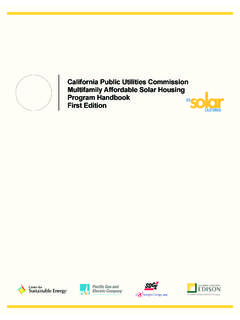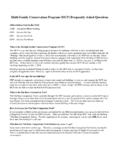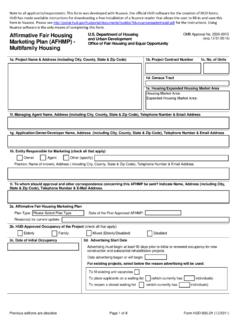Transcription of October 2016 Handbook for Multifamily Buildings
1 1 NYC Carbon Challenge Handbook for Multifamily BuildingsOctober 2016 The City of New YorkMayor Bill de BlasioMayor s Office of SustainabilityHandbook for Multifamily BuildingsNYC Carbon Challenge Handbook for Multifamily Buildings1impacts, while also mitigating rising housing costs and supporting the Citys affordable housing and sustainability goals. Reducing citywide GHG emissions is imperative to mitigating the worst effects of climate change and ensuring we are on a path to a more equitable, resilient, and sustainable city. The City has created several programs to work with private sector leaders to improve the energy efficiency of their Buildings and reduce GHG emissions. Two of these programs, the NYC Carbon Challenge and NYC Retrofit Accelerator, are outlined on the following page.
2 OverviewThis Handbook is a resource for building owners, building staff, co-op and condo board members, property managers, and all other building decision-makers to improve the energy efficiency of their Buildings by understanding the most effective energy conservation measures. By investing in energy efficiency, building decision-makers can improve building performance, save on utility and maintenance costs, reduce greenhouse gas (GHG) emissions, improve local air quality, and help ensure resident health and comfort. This resource introduces the basic principles of energy efficiency, incentive programs, available financing, relevant local laws, and technical training programs designed to reduce energy use and GHG emissions in New York City s diverse Multifamily building is ample opportunity to increase the energy efficiency in New York City s one million Buildings , of which nearly 100,000 are Multifamily properties.
3 While the Multifamily sector accounts for nine percent of the absolute number of citywide Buildings , it represents more than 40 percent of citywide building area and nearly 30 percent of citywide GHG emissions. Energy consumption in Buildings contributes directly to GHG emissions, which is a major contributing factor to global climate change. Because New York City is built primarily on islands with 520 miles of shoreline, it is particularly vulnerable to rising sea levels and other impacts of climate change. Reducing energy use in residential Buildings will help reduce these Credit: JD Malave, flickr2%11%11%3%6%12%3%15%29%9%41%29%82% 27%19%Buil ding CountAre aGHG Emissio ns1 to 4 FamilyMulti fami lyCommercialIndustrialInstitutionalSourc e: NYC Mayor's Office of Sustainability, Buildings Technical Working Group ReportBuilding uses by building count, floor area, and GHG emissions2 NYC Carbon Challenge Handbook for Multifamily Buildings Launched in 2007, the NYC Carbon Challenge is a voluntary leadership program that includes 17 leading universities, 11 hospital organizations, 12 commercial offices, 20 residential property management firms, and 19 hotels in New York City that have committed to reduce their GHG emissions by 30 percent or more over 10 years.
4 The Carbon Challenge works by inspiring a high-level commitment within organizations, creating a platform for the exchange of information and ideas, and providing simple tools to track progress. Current participants represent more than 265 million square feet of space and seven percent of New York City's building -based GHG emissions. Since the program started in 2007, eight participants have met the 30 percent goal, and all together, participants have collectively reduced their carbon emissions by 160,000 metric tons of carbon dioxide equivalent (tCO2e) and saved $175 million in annual you are a Multifamily building property manager, owner, or serve on a co-op or condo board and you are interested in being recognized for your commitment to energy efficiency and sustainability, you may be eligible to participate in the Carbon Challenge.
5 Participants in the Carbon Challenge will receive help to identify cost-saving ways to reduce their building s energy use and participate in a platform for the exchange of ideas and best practices with the City s leading residential property management firms and owners. More information about the Carbon Challenge can be found at: in 2015, the NYC Retrofit Accelerator is a free program provided by the City of New York that offers advisory services to building owners and operators during the steps required to successfully complete water and energy efficiency projects. The program builds on the success of the NYC Clean Heat program and includes assistance with local building energy laws, interpreting energy audit recommendations, selecting energy and water efficiency projects, identifying incentives and financing to help cover costs, and providing advisory services through project completion.
6 The NYC Retrofit Accelerator also continues the City s mission to assist all Buildings still burning heavy heating oil to convert to cleaner heating you are interested in joining the Carbon Challenge, the NYC Retrofit Accelerator is a resource to provide guidance on how to apply the strategies in this Handbook to your building . More information about the NYC Retrofit Accelerator can be found at: Carbon Challenge Handbook for Multifamily BuildingsTable of ContentsIntroductionBenefits of Saving EnergyOpportunities for Energy EfficiencyHow to Get StartedElectrical SystemsBuilding EnvelopeHeating and Cooling SystemsDomestic Hot WaterEfficient On-Site Generation and RenewablesOther Energy-Saving MeasuresSuccess StoriesAppendix A: Financial IncentivesAppendix B: Financing and Loans Appendix C: NYC RequirementsAppendix D: Technical ResourcesAppendix E: Training ResourcesAppendix F: Online ResourcesAcronyms Sources and End Notes46781113182729333642495558596164654 NYC Carbon Challenge Handbook for Multifamily Buildings On Earth Day 2015, New York City Mayor Bill de Blasio announced One New York.
7 The Plan for a Strong and Just City (OneNYC), the City s blueprint for a growing, sustainable, resilient, and equitable city. Recognizing the existential threat that climate change poses to New York City and the world, Mayor Bill de Blasio has set the ambi-tious goal to reduce citywide GHG emissions by 80 percent from 2005 levels by 2050. As part of the 80 x 50 goal, the City has set interim targets to reduce citywide GHG emissions 40 percent by 2030 and building -based GHG emissions 30 percent by 2025. With these commitments, New York City is continuing its longstanding leader-ship in addressing global climate New York City, roughly three-quarters of city-wide GHG emissions come from the energy used to heat, power, and cool Buildings . In addition, more than 90 percent of the Buildings that exist today in New York City will still exist in 2050.
8 This means that to achieve 80 x 50, nearly all of the city s existing Buildings will need to be ret-rofitted to become more energy efficient over the next three York City launched the NYC Carbon Chal-lenge in 2007 to partner with private and insti-tutional sector leaders across the city to achieve significant GHG reductions from some of the city s largest Buildings . Since then, 17 of New York City s leading universities, the 11 largest hospital organizations, 12 global companies, 20 residential property management firms, and 19 hotels have accepted the Challenge, pledging to reduce their building -based GHG emissions by 30 percent or more in ten City launched the NYC Carbon Challenge for Multifamily Buildings in 2013 to work with industry leaders committed to improving building performance through energy efficiency retrofits.
9 Since then, the 20 residential property manage-ment firms featured on the following page have accepted the Challenge, pledging to reduce their building -based GHG emissions by 30 percent in ten years. Introduction Credit: NYC HPD 051015202530354045 Base Year -17% End Year Diesel Fuel No. 4 Oil No. 6 Oil Electricity No. 2 Oil Steam Natural Gas tCO2e / Square Foot Carbon Challenge progress to date (GHG emissions intensity for Universities, Hospitals, and Commercial Offices)Source: NYC Mayor's Office of Sustainability5 NYC Carbon Challenge Handbook for Multifamily BuildingsParticipating residential property management firms and owners in New York City have now committed more than 900 Buildings to the Carbon Challenge for Multifamily Buildings , pledging to reduce GHG emissions by 30 percent across selected portfolios.
10 All together, these Buildings represent over 110 million square feet, or more than six percent of the city s large and mid-sized residential square footage. Participants represent diverse segments of the Multifamily building sec-tor, with nearly 60 percent of participating build-ings serving low and moderate income City is committed to expanding participa-tion in the Carbon Challenge for Multifamily Buildings by doubling the size of the program to include additional Buildings and property man-agement companies that have demonstrated lead-ership in energy efficiency and GHG emissions , NYC Carbon Challenge participants across all sectors have cut their annual emissions by 190,000 tCO2e and are collectively saving almost $175 million in lower energy costs. By the end of the program, current participants are projected to reduce citywide emissions by near-ly 510,000 tCO2e - equivalent to removing more than 100,000 cars from the joining the Challenge, participants gain ac-cess to information on ways to reduce energy use and emissions, save money on energy bills, and improve local environmental quality all while being recognized by the City for their efforts.
















